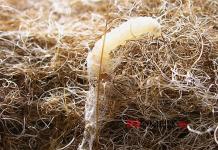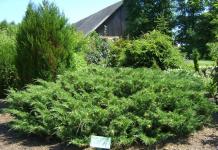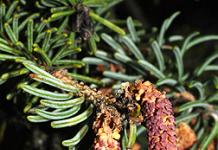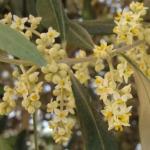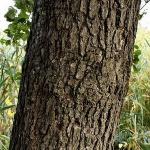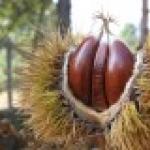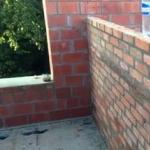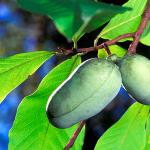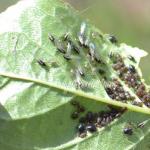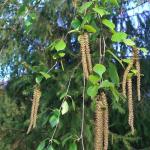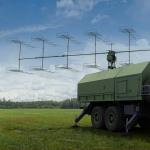smaller cones, and fragrant when rubbed with pine needles and shoots (they have the smell of black currant).
Picea glauca needles
In areas where habitats intersect R.Glauca And constant hybridization occurs, which significantly complicates taxonomy. Two subspecies recognized R.Glauca v. albertiana – outwardly differs from the main species in its unusually narrow crown, the shoots are slightly pubescent and the leaves are slightly longer (1.5-2 cm, in contrast to the length of 0.8-1.3 cm in the main species). P . Glauca v. Porsildii described as differing from the type variety by having smooth bark with resinous nodules and an unusually wide crown.

Male cone Picea glauca
Description of the species. A tall tree 40-50 m, with a trunk diameter of 1 m, with a dense, cone-shaped, broadly conical, compact crown formed by dense branches, in young trees directed obliquely upward, and in old trees downward. The bark is grey-brown. The shoots are slightly drooping, light gray-yellow, sometimes completely white, glabrous, less often slightly hairy. The leaf cushions usually protrude strongly at the base of the shoot; last year's ones are straw-yellow. The buds are orange-brown up to 3-6 mm long, light brown, rounded-ovoid, blunt, triangular at the tip, shiny, without signs of resin. The tip of the kidney scales is usually bent, the kidney scales sit in the form of a corolla.

Opened old and young female cones of Picea glauca
The needles at the top of the shoot are very thick, spirally arranged, needle-shaped, short, 8-10 mm long, spaced from the shoot, slightly curved. Needles (0.8) 1.5-2 (2.5) cm long, 1-5 mm wide, tetrahedral in cross-section, unlike prickly spruce, blunt; on the upper side with 2-3, below with 3-4 stomatal lines merging into a stripe; bluish-white in color, which is why the needles as a whole appear to be the same color on both sides. Lives 5-7 years.

Old open cones of Picea glauca
Blooms in late spring. Male anthers are red or yellow in color. Numerous female cones are green or pale purple, small, 3-6(8) cm long, 1.5-2 cm in diameter. Mature ocher, light brown, oblong-cylindrical, soft, loose, rounded on both sides, with whole small, bent, round-ovate, spirally arranged seed scales. Covering scales are small, obovate, blade-shaped. Seeds up to 2 mm long, brown, with a light brown wing about 6 mm long.

Picea glauca bark
Ecological property of the species. This is one of the geographically most widespread breeds, growing in North America from Alaska to Newfoundland, and south to the northern regions of British Columbia. In the north, the distribution area is limited to forest-tundra, in the south - by the states: Minnesota, Wisconsin and Michigan, northern Montana, Maine, Wisconsin, also isolated populations in South Dakota and Wyoming, in the east - New York State. Rise into the mountains to a height of 1900 m ( R.v. albertiana
- up to 2100 m). It grows in swampy lowlands, river and mountain slopes, where it is the dominant species in taiga forests in the vast expanses of Canada and Alaska.
Lives 400-500 years. One of the oldest trees is 668 years old. In the BS BIN RAS it has been noted in catalogs since 1816. At a young age it grows faster than other types of spruce. After 20 years, growth declines. During active growth, it is most decorative due to the intense bluish color of the needles. At 60-70 years old, height is 18-20 m, diameter 30-40 cm.

General view of a young Picea glauca tree
In the Republic of Belarus it develops well, achieving high decorative value, sometimes found in gardens and parks, rarely in protective zones, as well as in forest plantations. The oldest trees grow in the Svisloch park of the Grodno, Dobrygory parks of the Beshenkovichi district, as well as in the Zhernovskaya LOS. In the Botanical Garden of the BIN RAS it has been noted in catalogs since 1816, and is still grown today. Also available in the collections of the Forestry Academy and the Otradnoe Scientific Experimental Station.
It has been known in GBS since 1973, where 14 samples grown from seeds were planted. Trees, at 33 years old, reach a height of 15 m, with a trunk diameter of 25-33 cm. Vegetation from April 26 ± 8 days. Annual growth is 15-28 cm. It is dusty from 8 years old, annually, abundantly, from May 14 ± 6 days to May 23 ± 8 days. The seeds ripen by mid-September. Has increased winter hardiness. Suitable for growing in zones 1-8 (frost resistance limit between -45.6°C and -40.0°C). Rarely found in landscaping.
In the Republic of Belarus it develops well, achieving high decorative value, sometimes found in gardens and parks, rarely in protective zones, as well as in forest plantations. It grows successfully in both maritime and continental climates. Quite drought resistant. Not picky about soils, tolerates poor and sandy soils. It resists strong winds and snowfall well, is shade-tolerant, but develops better with sufficient lighting. Prefers acidic loams. Resistance to urban conditions is lower than that of prickly and Serbian spruce, but higher than that of common spruce.

Mature Picea glauca trees
Reproduction and cultivation. Propagated by seeds and vegetatively. Winter cuttings do not take root without treatment. Cones ripen at the end of September, seed germination in single trees is from 1%, in groups – 90%. The permissible shelf life of seeds is 4 years. Seed viability 71%. Freshly harvested seeds germinate poorly; stratification at +1 C for 1-2 months increases germination. They are sown in bowls or in ridges to a depth of 1 cm. In local conditions, fruiting occurs at 8-10 years. It produces viable seeds every year. Agricultural technology is the same as for other spruce trees.
Purpose and application. The tree resists winds well, so it is bred as a wind- and snow-protective tree. In the USA and Canada it has serious timber industry importance. A desirable breed for widespread introduction into forestry in the CIS. There is no difference between sapwood and heartwood. The wood is almost white to pale yellowish-brown in color (very reminiscent of Norway spruce wood). It is straight-grained, shiny, only slightly resinous, with a dry density of about 416 kg/m³.
The wood is very easy to process, but sometimes some complications are possible due to knots. When the cutting edges are sharply sharpened, the wood produces a smooth finishing surface. It is suitable for dye etching, polishing, painting, and gluing. Similar to Scots pine wood of the same varieties, not resistant to rotting. Wood is widely used to create lightweight temporary and medium-sized buildings with a service life; oars, parts for ladders, boards for formwork, oil boxes, and kitchen furniture are made.
Resonators for grand pianos and pianos are made from selected assortments. The wood is widely used to produce pulp for paper and for further chemical processing into viscose and cellophane. Yellow dye can be made from crushed rotten wood, and ropes and baskets can be weaved from the roots.
Landscape construction. Particularly beautiful in early summer during flowering. Perfect for decorating rocky hills and forming thorny hedges. Tolerates pruning satisfactorily. It has a large number of decorative forms. Despite the fact that it is somewhat inferior to prickly spruce in terms of decorativeness and resistance to urban conditions, it is successfully used in garden and park plantings.
| Canadian spruce, gray, white (Picea canadensis, glauca, alba) | ||
|---|---|---|
| Height in nature/culture/trunk d | 30/40m (1.2 m) / 12-21 m | |
| Frost resistance, °C | -45,6 | |
| Crown volume (mm) / height (m) | 11m x 18m |
|
| Habit | The crown is dense, pointed pyramidal with age - columnar or pyromidal | |
| Trunk diameter (cm) / age (years) | 50 cm in 120 years | |
| Growth rate: height/width | Medium height 30/40cm/year | |
| Age/in culture | 500/300 years | |
| Light/shadow | ☼○◘ | |
| Drought resistance | ▓▒░ does not like waterlogging and dryness | |
| Wind resistance | wind resistant | |
| Sustainability in the city | good | |
| Soil fertility | undemanding | |
In contact with
The decorative Konika is unusually beautiful - a dwarf form of the gray Canadian spruce. It was her attractive appearance that opened the doors for this little beauty to the world of gardening, where she was joyfully and unconditionally accepted. Today this mini-Christmas tree decorates various corners of the Earth.
It also grows well in the middle zone of our country. Distinguished by its winter hardiness, Canadian spruce Konica can grow wherever ordinary spruce trees grow. And its small growth turned out to be a great advantage, allowing the tree to settle even in a small area.
Description of Canadian spruce Konica
Konica is a decorative form. Under favorable conditions, the height can be up to 3 m, but more often it grows up to 1 m.
The crown is narrow-cone-shaped, dense. The needles are bluish-green, soft, thin and short. The root system of Konica is represented by a compact, weakly expressed taproot. The predominant part of the roots is located quite close to the soil surface, so loosening must be careful.
This tree grows very slowly - only 3-4 cm per year. But some specimens can still gain up to 10 cm in height per year. At the age of five, the height of the Christmas tree reaches only 20 cm, but already at this age it differs in decorativeness from the same-age seedlings of common spruce. By the age of 10, the Christmas tree grows up to 80 cm. Good growth is maintained until 10-15 years, when the height of the plant is about 1 m. Subsequently, the intensity of growth decreases and amounts to only 2-3 cm per year. This increase will continue into old age. By the age of 20, the height is 150 cm, the crown in diameter at the base is about a meter.
Canadian spruce Konica Maygold is a variety of gray spruce characterized by yellow growths. In other characteristics, the variety is similar to Konica and Daisy White.
How to care for Canadian Konica spruce
This variety of spruce is convenient because its care is minimal. Konika does not need crown care - it does not need pruning. Natural soil fertility and natural precipitation are sufficient. But if the Canadian Konica spruce grows on the site, it still needs to be cared for, even minimally. This will only enhance its decorative properties.
In case of excessive drought, irrigation through the crown is useful. 1-2 days after this, it is advisable to shallowly loosen the soil under the tree. With the arrival of summer, you need to feed the spruce. To do this, you can add 5 kg of rotted organic matter to the root zone and mix it with the soil. With the arrival of October, it is recommended to mulch with a layer of peat compost 5 cm thick.
This way the plant will overwinter better. In early spring, mulch is incorporated into the soil. To prevent spring browning (burning in the sun), Christmas trees should be wrapped in burlap or some other material that will protect from the sun without affecting ventilation.
Spring browning of needles is not a disease. This is just the plant’s reaction to spring solar activity against the background of frozen soil. In other words, the tree begins its seasonal growing season, and the unmelted soil is not yet able to provide the roots with the necessary nutrition, so the needles begin to turn brown. But when the sap begins to flow and when there is sufficient nutrition, the color of the needles tends to be restored.
Planting Canadian spruce Konika
Canadian spruce can be replanted throughout the growing season. Konica, the planting of which is not so difficult, still requires compliance with certain requirements. So, at the beginning of spring and in autumn, transplanting with an open root system is optimal.
In summer, it is recommended to transfer the plant on its roots with a lump of earth. It is better to do this in cloudy weather. For 2 weeks after planting, the Christmas tree needs to be protected from direct sunlight and the soil maintained at an optimal moisture level. Transplantation is better tolerated at a young age.
Application of Konica
Canadian spruce Sonica is very popular in landscape design. She is good both in solo performance on the lawn and in a group. Due to its slow growth, it is practically not used in flower beds, but when it reaches a certain height, the tree looks great in mixborders.
Canadian dwarf spruce Konica is spectacular in a variety of compositions. It can very often be found in containers on the roof (“green” roof), terraces, near houses, and when decorating gardens. The decorative form is good in large rock gardens. Looks great in the background of flower arrangements, and also harmoniously combines with other low-growing conifers. Konika looks especially beautiful on a smooth, trimmed lawn.
Canadian spruce Konica in a pot in the photo
Growing spruce in a pot is not at all difficult, as long as you know the technology. To start a “homemade” Christmas tree, you can buy a ready-made one in a store, you can grow it from seeds or dig up a seedling in the forest. Whatever method is chosen, the seedling must be very carefully transplanted into a container. It is important to ensure that the root collar of the plant remains at ground level. The root system must not be allowed to dry out. By the way, a Christmas tree bought in a store needs to be replaced with soil.

For all types of spruce, the soil should have the following recommended composition: leaf soil, turf soil, sand, peat in a ratio of 2:2:1:1. It is advisable to lay drainage (gravel, coarse sand, expanded clay) in a layer of 10 cm at the bottom of the container or pot. When planting/transplanting, it is advisable to apply fertilizer at the rate of 100 g/m2. General fertilizing is applied at the rate of 15-20 g per container 2 times per season.
Although spruce trees are shade-tolerant, an optimal light regime is still recommended. In winter, the gray spruce Konika requires sufficient humidity (80-90%) and an optimal temperature of +5-15 °C. The tree does not tolerate dry soil well, but waterlogging is not recommended. To maintain an optimal level of humidity, you can mulch with peat, the layer of which will be 5-6 cm. Periodically it is mixed with soil, and new mulch is added on top. Canadian dwarf spruce Konica grows slowly and does not need pruning, you can only remove diseased and dry branches.
In summer, it is better to place the pot or container under trees or shrubs. Drip irrigation is recommended. Every year the Christmas tree needs to be replanted in a larger pot and with special compost.
The advantage of dwarf forms is that, under favorable conditions, they can live for a long time in pots and containers. An ordinary spruce in a container can live no more than 3-4 years.
Konika in a pot for the New Year
Today it is considered very fashionable to have a potted plant as a New Year's tree.
For such a New Year's tree, you need to choose a place away from radiators and other heat sources. It is best to place the pot on a cold window, but given the “New Year’s” purpose, this is not always possible. In addition, a south window is not an option, since the young plant is afraid of direct sunlight. Wherever the pot stands, it is necessary to periodically turn it in relation to the light.
When keeping Konica in a heated room, it is necessary to spray the crown. It would be better to try to increase the air humidity near the tree itself. To do this, you can place containers of water around the pot. Another way to increase humidity: place the edge of a towel in a container with water, and hang the other edge on the radiator. With this method, you will have to constantly add water, as the water will evaporate quickly.
After the holidays are over, it is recommended to move the Christmas tree to a loggia or glazed balcony. There, the pot with Konika can be covered with a cap, which will ensure optimal humidity. You can use a 5-liter bottle without a bottom. The lid remains and the spruce is completely covered with the bottle. To prevent the soil in the pot from freezing, you can wrap it in something warm. It is very important for potted Konica to provide a more or less cold winter, because this is, after all, not a tropical plant.
When the root system completely fills the container, it is necessary to transfer the tree, without damaging the earthen ball, into a larger container.
If all the stated requirements are met, the decorative spruce will delight you with its beauty and originality for a long time.
These evergreen Christmas trees have always been considered the best decoration for the garden, because their decorative forms are ideal for landscaping and creating various garden compositions.
The most popular coniferous tree in our time is considered to be Canadian spruce and its low-growing conic form.
This tree is sure to become the highlight of the garden plot, thanks to the color of the needles and the surprisingly regular shape of the crown. Konica can grow both in open ground and in a pot, delighting you with its beauty all year round.
Botanical description
 Gray conika spruce is a decorative form of a popular Canadian type of spruce. This tree has several more names that can often be found in the literature: white conic, glauca conic, gray conic. All these names extremely accurately describe the appearance of the spruce, which has bluish-colored needles.
Gray conika spruce is a decorative form of a popular Canadian type of spruce. This tree has several more names that can often be found in the literature: white conic, glauca conic, gray conic. All these names extremely accurately describe the appearance of the spruce, which has bluish-colored needles.
This tree is considered a small copy of the gray spruce and great for landscape design. In 1904, the first mention of this coniferous tree was recorded, when a similar konica spruce was found in the mountains of Canada.
After that, it quickly spread throughout the world. And not in vain. After all, planting a huge coniferous tree on your site is quite difficult. Therefore, in such a situation, the best solution would be decorative spruce, which fits perfectly into absolutely any landscape design.
Description of the Canadian Christmas tree:
- This type of spruce belongs to the evergreen coniferous trees.
- Decorative form of a Canadian dove-gray Christmas tree. The decorative value of this tree is considered to be its height and the correct shape of the crown.
- Konik spruce reaches one meter in height, which is very convenient for home use. Under such growing conditions it can grow up to three meters.
- Can reach two meters in diameter.
- It grows quite slowly. During the first 10 years of life, it grows only 6 or 10 centimeters per year. At the end of this period, the growth decreases significantly - to 3 centimeters.
- Konica is considered a long-liver, as it can grow in one place for 300 to 500 years.
- The decorative form of the Canadian spruce has the correct original shape of the crown, which looks like a narrow cone. The most important feature of the tree is that the crown does not require any maintenance, since it takes its shape naturally.
- The crown is extremely dense, consisting of short needle-like needles reaching one centimeter in length. The color of the needles is bluish-green. Spruce needles do not prick at all, so it is completely safe for children and pets.
- It is quite rare to see cones on Canadian spruce. They are characterized by a conical oblong shape, which reaches a length of 6 centimeters.
- The root system is superficial, so you need to be careful when loosening the soil around the spruce.
The Canadian Christmas tree has several mutant varieties:
- "Dwarf".
- "Alberta Globe".
- "Elegance Compacta".
- "Laurin."
Konika spruce: planting and care
 Landing technology. To get a beautiful and healthy evergreen coniferous tree, you need to carefully prepare.
Landing technology. To get a beautiful and healthy evergreen coniferous tree, you need to carefully prepare.
First you need to select and purchase high quality seedlings or prepare, grown with your own hands. It will also be important to find a suitable place for landing.
Selection of seedlings. In most cases, spruce seedlings are purchased in special nurseries, and much less often they are grown at home. When purchasing, it is important to follow some rules:
- It is best to purchase a seedling in a pot with a closed root system. In this case, you will have the opportunity to plant it at any time from autumn to spring.
- If you bought seedlings with an open root system, you need to plant them immediately.
- With all this, do not lose sight of the root system; it should be with a clod of soil and carefully covered with burlap. This will help prevent damage to the roots.
- Look carefully at the seedlings. They should not have dried or damaged branches.
- It is recommended to buy seedlings from special nurseries, so you will be confident in what you are buying.
Choosing a landing site
 This tree likes to grow in open, well-lit areas with little shade because it can be susceptible to sunburn. If you plant a coniferous tree in the shade, it will quickly begin to lose its decorative characteristics and the color of its needles.
This tree likes to grow in open, well-lit areas with little shade because it can be susceptible to sunburn. If you plant a coniferous tree in the shade, it will quickly begin to lose its decorative characteristics and the color of its needles.
In addition, it is very important that the chosen location is well protected from the wind, and there was no close groundwater underneath it, because the Canadian fir tree is not able to tolerate stagnant water.
Please note that near Huge trees didn't grow. Otherwise, the spruce will not have enough space and may lose its decorative characteristics.
The choice of area for planting depends on the desired garden composition and your landscape design. It is important to remember that there is no need to plant a Canadian Christmas tree within the city limits - it cannot tolerate polluted air and therefore may die.
Soil preparation and planting process
 Konik spruce is an unpretentious tree and will grow virtually anywhere. But to preserve its decorative distinctive features and eye-catching crown color, you need to choose a grassy area.
Konik spruce is an unpretentious tree and will grow virtually anywhere. But to preserve its decorative distinctive features and eye-catching crown color, you need to choose a grassy area.
The soil must be light and loose, excellent air and water permeability. It is very good if the soil is generously enriched with organic matter. In addition, the area needs to be thoroughly dug up before planting.
You can plant a Canadian Christmas tree in open ground summer, autumn and spring. But you need to know a few rules, since planting differs depending on the time of year.
- In autumn and spring, seedlings must be planted with bare roots. In summer, the planting material must be with a clod of earth, because there is a possibility of damage to the roots, since the root system of the spruce does not tolerate dry, hot air.
- It is necessary to start planting by preparing the land. For spruce, a soil mixture of leaf and turf soil, sand, and peat in equal proportions is suitable. You can also add organic matter.
- Next, you need to dig a planting hole, the volume of which will depend on the size of the seedling itself and its rhizome.
- The bottom of the pit can be covered with a drainage layer, which consists of crushed stone or broken brick.
- Next, pour out some of the prepared soil, to which you can add complex fertilizer.
- We place the seedling on this ground and sprinkle it with the remaining soil.
- After planting, do not forget to water the tree; one seedling requires approximately 10-12 liters of water.
- After this, it is imperative to mulch the tree trunk circle to save water. Peat is used as mulch.
Features of care
 The upcoming care of the spruce does not require special efforts or any labor-intensive actions. But you need to pay attention to the tree so that in the coming time it will amuse you with its luxurious crown and eye-catching coloring of the needles.
The upcoming care of the spruce does not require special efforts or any labor-intensive actions. But you need to pay attention to the tree so that in the coming time it will amuse you with its luxurious crown and eye-catching coloring of the needles.
Watering rules. Canadian spruce prefers regular moderate watering, especially when it is hot outside. In this case, young trees need to be watered 2 times a week, using 10 liters of water for each seedling.
This tree, among other things, prefers sprinkling, therefore, using a watering can or hose, you should spray the needles several times a week. But be careful not to flood the root system.
Loosening and mulching
From time to time you should loosen the tree trunk circle, but this must be done extremely carefully, since the spruce rhizome is close to the surface and you have the opportunity to damage it.
After loosening, be sure to mulch the soil. Used as mulch peat or compost. This mulch perfectly protects the tree from the appearance of a huge number of weeds and drying out.
Shelter
Young tree seedlings need protection from direct sunlight, because they can get burned and die. Cardboard and burlap are used as protection. It is necessary to cover in the fall for the entire period of cold weather, while leaving the lower part of the spruce open.
Top dressing
When complex fertilizers and organic matter are added to the ground during planting, at first the seedlings do not need additional feeding. Then, with the arrival of summer, you can feed the tree with various organic fertilizers, which are diluted with water.
Trimming
The Canadian Christmas tree is famous for its regular conical crown shape, which virtually does not require pruning. In spring and autumn, you can carry out sanitary pruning, during which you remove all dried, broken and damaged branches.
Canadian Christmas tree in landscape design
Canadian spruce is extremely popular among landscape designers due to its decorative features, which is why it is often found on sites. Methods of using wood in landscape design:

We liked how in the movies they decorate the fir trees for New Years and Christmas in front of the house, so we wanted something similar for ourselves. We thought and thought and settled on Konik. Firstly, its size is ideal for small areas, and secondly, it looks great all year round, especially since it can be planted in a pot and kept in the house in severe frosts (though the temperature in winter should not be higher than +5, we will place it in the summer kitchen).
The spruce was planted according to science, so we worked hard, selecting a pot and preparing the mixture for planting. For drainage, we took expanded clay, in a layer of approximately 8-10 cm. The soil mixture consisted of: 2 parts each of leaf and turf soil and 1 part each of sand and peat. Well, the landing itself was the same as on this page.
We gave this conika in a pot for the New Year. And then by February she began to look somehow worse. I rushed to the forums and was immediately shocked! It turned out that these beauties will not live at home; they need cold wintering and outdoor conditions.
We had to take it out onto the loggia; it’s open and almost always windless. The food there was much better. To prevent frost from destroying the root system, the pot was wrapped in thermal insulation that was left over from the walls. Until spring I water it very moderately. On especially frosty days, I took it into the house and placed it near the balcony block, where there is maximum light and away from heat. In the spring, I took the spruce to the dacha and planted it in the ground. I hope that he will cope well with the next New Year on the ground.
The Canadian spruce Glauca conica grows in the garden. In winter I did not cover it, because... I didn’t think that the spruce could get sunburn, but at the end of March the top of the spruce began to turn brown. When I started to find out why, it turned out that it was all the fault of the sun, which, reflected from the snow, caused damage to the needles.
Trying to revive the branches, I carefully removed the damaged needles using a hose with water. Then I simply frequently moistened the “bald” branches with a watering can. Recently, hints of new needles appeared in those places where living buds remained, and the burn areas began to heal.
Next winter I will cover the spruce with burlap, because... I heard a lot of negative reviews about the special material that is sold in the store.
I have long been attached to these Christmas trees, so I will share my experience in replanting. It is better to do this at a young age. If I need to replant a tree in spring or autumn, then this can be done with an open root system. If a spruce needs to be replanted in the summer, then only with a clod of earth. It is better to transplant on cloudy days.
After replanting, at first it is important to maintain optimal soil moisture and protect from direct sunlight.
From my own experience, I know that many novice gardeners are interested in how to care for a purchased spruce tree. The first thing to remember is the condition of the soil. If a tree is in waterlogged soil, its roots begin to rot and die. Christmas trees get sick for a long time and then die. Spruce also does not tolerate prolonged drought.
A site for spruce should be chosen with low groundwater and low precipitation. At the same time, it is good if there is a pond or reservoir next to the spruce, because... humid air will have a positive effect on the color of the needles and reduce the likelihood of them burning out.
Canadian spruce is a decorative form of spruce. Its height is up to 1 meter, but under certain conditions, the spruce can reach 3 meters. Its appearance is quite original: cone-shaped, bluish-green color, the tree is characterized by softness and short shape, a weak tap root and the root system is located close to the soil surface. As a result, loosen the soil very carefully.
Features of growth
 Konika spruce grows slowly, only 3-4 cm grows in a year. There are certain species that grow up to 10 cm. When the spruce is 5 years old, its height is approximately 20 cm, at this age it already stands out for its decorativeness. At 10 years old, Canadian spruce reaches a height of 80 cm. It grows for 10-15 years and reaches a level of 1 meter. In the following years, spruce growth is characterized by some slowness, only 2-3 cm per year. When the spruce reaches twenty years of age, its height is 1.5 m, and the diameter of the base of the roof is 1 m.
Konika spruce grows slowly, only 3-4 cm grows in a year. There are certain species that grow up to 10 cm. When the spruce is 5 years old, its height is approximately 20 cm, at this age it already stands out for its decorativeness. At 10 years old, Canadian spruce reaches a height of 80 cm. It grows for 10-15 years and reaches a level of 1 meter. In the following years, spruce growth is characterized by some slowness, only 2-3 cm per year. When the spruce reaches twenty years of age, its height is 1.5 m, and the diameter of the base of the roof is 1 m.
Caring for Canadian spruce
Konik spruce requires minimal care. The tree crown does not require pruning. It has enough natural precipitation. But still, at least minimal care is required.
If there is a drought outside, then spruce must be irrigated through the crown. A few days later, it is recommended to slightly loosen the soil. When summer comes, it is necessary to fertilize the conika spruce. To do this, take 5 kg of rotted organic matter and mix it with the soil in the root zone. When October comes, you need to lay a layer of peat compost 5 cm thick. As a result, the tree will better withstand the winter. To prevent spring browning, you need to wrap the conika spruce with burlap. This will serve as a protective element from the sun and will not interfere with ventilation.
Spring browning of spruce is not a disease. In this way, Canadian spruce reacts to solar activity after winter. We can say that this is a seasonal growing season. Soil that has not melted cannot fully saturate the roots with the necessary nutrition, as a result of which the spruce begins to turn brown. When the juice begins to flow and the conika spruce has sufficient nutrition, its color is restored.
Planting Konica
Canada spruce can be replanted during the growing season. Planting Canadian conika spruce is not very difficult, however, it is recommended to adhere to certain rules:

Application of Canadian spruce
Konica is often used in landscape design. The tree looks great alone, as well as in a group. As for flower beds, it is planted there very rarely due to its slow growth.
Spruce is used for various compositions. It is planted on terraces, near the house, in containers, and is also used to decorate the garden. An excellent option for conics is a smooth, mowed lawn. Wood is used for the background of flower arrangements, are also combined with other conifers that are short in stature.
 Canada spruce can be grown in a pot. To do this, you need to purchase it in a store, dig it up in the forest, or grow a seedling from seeds. This the seedling must be carefully transplanted into a pot, the root collar of the spruce should be at ground level. In this case, the root system should not dry out. If you bought Canadian spruce in a store, you need to replace the soil.
Canada spruce can be grown in a pot. To do this, you need to purchase it in a store, dig it up in the forest, or grow a seedling from seeds. This the seedling must be carefully transplanted into a pot, the root collar of the spruce should be at ground level. In this case, the root system should not dry out. If you bought Canadian spruce in a store, you need to replace the soil.
To create soil for spruce, you need to take turf and leaf soil, sand and peat, the ratio should be as follows 2:2:1:1. Place drainage at the bottom of the flowerpot, which has a layer of 10 cm. When you plant or replant spruce trees, it is recommended to make fertilizer. Twice a season you need to do general fertilizing.
For normal functioning of the conic spruce you need:
- set the light mode to normal;
- in winter it is necessary to provide the necessary humidity (80-90%) and normal temperature (+5-15 degrees);
- To prevent drying out or waterlogging, mulch with peat, its layer should be 5-6 cm. Mix this layer with the ground from time to time, and put a new layer on top.
Canadian spruce is characterized by slow growth and no need to trim it. Only dry and diseased branches should be removed.
When summer comes, take the container with the spruce outside under the trees. Do drip irrigation. Replant it in a larger pot every year.
Under good conditions, conika can live in a flowerpot for a long time than an ordinary spruce, which can only exist in a pot for 3-4 years.
Canadian spruce for the holiday
 Due to modern trends Decorating a spruce tree in a flowerpot for the New Year is considered very fashionable. When installing this plant as a New Year tree, you need to find a place that will be remote from various heat sources. The best option would be to place the container on a cold window, however, if you use the spruce as a Christmas tree, this is not very possible. Under no circumstances should you place the flowerpot on a south window, as there is a lot of sunlight there, and the tree does not tolerate direct sunlight. In any place where you place a flowerpot, you need to turn it towards the light from time to time.
Due to modern trends Decorating a spruce tree in a flowerpot for the New Year is considered very fashionable. When installing this plant as a New Year tree, you need to find a place that will be remote from various heat sources. The best option would be to place the container on a cold window, however, if you use the spruce as a Christmas tree, this is not very possible. Under no circumstances should you place the flowerpot on a south window, as there is a lot of sunlight there, and the tree does not tolerate direct sunlight. In any place where you place a flowerpot, you need to turn it towards the light from time to time.
If the Canadian spruce is placed in a heated room, then you need to spray the crown from time to time. The best option would be if the air humidity is higher near the konica spruce. To do this, you can place a bowl of water near the flowerpot. Or you can also do this: put one edge of a towel in a bowl with water, and place the other on the radiator. If you use the latter method, then do not forget to regularly add water to the dishes because it evaporates quickly.
When all the holidays are over, move the conika spruce to the loggia or balcony, if it is glazed. In this room, cover the flowerpot with the spruce with a cap, this will give the plant the necessary humidity. As a cap, you can take a five-liter bottle that has no bottom. Wrap the flowerpot in warm material to prevent the ground from freezing. But don’t overdo it with insulation, create optimal winter weather for spruce, because it is not a tropical plant.
If it happens that the root system completely fills the entire pot, it needs to be transferred with lumps of earth into a larger pot.
If you follow and adhere to all the rules for caring for the spruce and create the necessary conditions for it, then the Canadian conic spruce will delight you with its beauty for many years. It will perfectly decorate a room in the house, and will also create the uniqueness and originality of landscape design.
